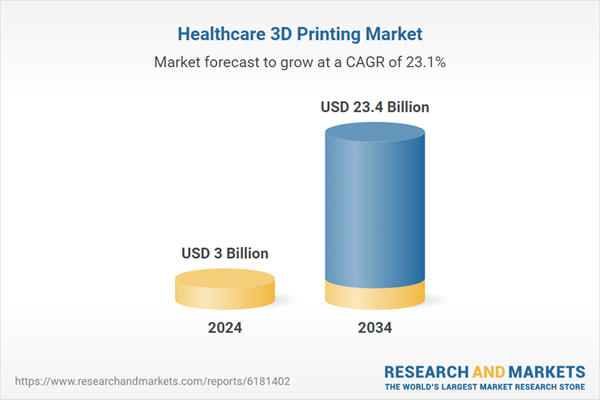The rapid growth is fueled by increasing demand for personalized medical solutions, rising investments in research and development, and the growing range of clinical uses. As healthcare systems shift toward more patient-specific and precision-driven approaches, 3D printing continues to play a critical role across surgical planning, prosthetics, and regenerative medicine. The growing elderly population, coupled with advancements in bioprinting and implant customization, is accelerating the need for efficient, accurate, and cost-effective technologies. Healthcare institutions and academic centers are setting up in-house 3D printing labs, improving response times, and enhancing patient care. These efforts reflect a larger industry movement toward integrating digital design and additive manufacturing for improved diagnostics and treatment outcomes. As awareness increases around the value of 3D printed solutions in the healthcare setting, adoption is rising across hospitals, labs, and specialized care facilities, further solidifying the market’s upward trajectory.
A typical healthcare 3D printing setup includes a 3D printer or bioprinter, dedicated software for design, and medically safe materials such as metals, polymers, or hydrogels. These systems transform imaging data from CT or MRI scans into precise physical models or patient-specific medical devices, allowing for highly tailored healthcare interventions.
In 2024, the equipment segment held a 29.3% share, driven by the growing installation of sophisticated 3D printers across healthcare settings. Hospitals and labs are increasingly adopting this technology to produce personalized tools, anatomical models, and implants in-house, significantly reducing wait times and improving surgical planning. The trend of point-of-care manufacturing is gaining momentum, positioning equipment as a central pillar in the healthcare 3D printing landscape. As the focus continues to shift toward personalized care and operational efficiency, demand for reliable and high-performance equipment is expected to grow consistently.
The stereolithography (SLA) segment is expected to grow at a CAGR of 22.9% through 2034. SLA is favored for its high-resolution output and exceptional accuracy, making it ideal for creating complex medical structures. Its use spans across multiple applications such as dental prosthetics, patient-specific guides, and anatomical models, making it the go-to technology for precise, detailed medical printing.
North America Healthcare 3D Printing Market held a 42% share in 2024. The region’s growth is supported by advanced healthcare infrastructure, early adoption of innovative technologies, and consistent funding for medical research. A well-integrated ecosystem involving manufacturers, healthcare providers, and regulatory agencies makes North America a hotspot for 3D printing advancements in healthcare. Hospitals across the U.S. and Canada are embracing this technology for patient-specific implants, surgical modeling, and prosthetic design.
Key players shaping the Global Healthcare 3D Printing Market include: formLabs, OPM, nanoscribe, PROTOLABS, 3D Systems, stratasys, Axial3D, ExOne, EOS, RENISHAW, materialise, ETEC, and KONICA MINOLTA. Companies operating in the Healthcare 3D Printing Market are focusing on strategic R&D investments to improve material biocompatibility, print speed, and resolution. Many are expanding their product portfolios to include software, service solutions, and bioprinting capabilities. Collaborations with hospitals, research centers, and universities help to accelerate innovation and broaden clinical applications. Several players are also building region-specific partnerships to strengthen their distribution channels and improve access to point-of-care 3D printing. Customization is a major focus, with firms offering tailored solutions for implants, surgical planning, and dental applications. Regulatory compliance and certifications remain a priority, ensuring safe integration into medical settings.
Comprehensive Market Analysis and Forecast
- Industry trends, key growth drivers, challenges, future opportunities, and regulatory landscape
- Competitive landscape with Porter’s Five Forces and PESTEL analysis
- Market size, segmentation, and regional forecasts
- In-depth company profiles, business strategies, financial insights, and SWOT analysis
This product will be delivered within 2-4 business days.
Table of Contents
Companies Mentioned
The companies profiled in this Healthcare 3D Printing market report include:- 3D Systems
- Axial3D
- Eos
- ETEC
- ExOne
- Formlabs
- KONICA MINOLTA
- Materialise
- Nanoscribe
- OPM
- PROTOLABS
- RENISHAW
- Stratasys
Table Information
| Report Attribute | Details |
|---|---|
| No. of Pages | 140 |
| Published | October 2025 |
| Forecast Period | 2024 - 2034 |
| Estimated Market Value ( USD | $ 3 Billion |
| Forecasted Market Value ( USD | $ 23.4 Billion |
| Compound Annual Growth Rate | 23.1% |
| Regions Covered | Global |
| No. of Companies Mentioned | 14 |









